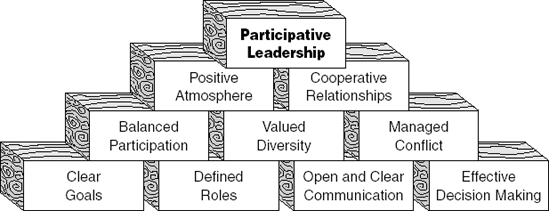
New clients, unlock 10% off all plans 🔥 at checkout with code: CEO10SPECIAL (Limited Time Offer)
New clients, unlock 10% off all plans 🔥 at checkout with code: CEO10SPECIAL (Limited Time Offer)






Effective leadership is the lifeblood of any successful organization, guiding teams towards shared goals and driving growth and innovation.
While traditional top-down leadership styles have long dominated the corporate landscape, a refreshing approach known as participative leadership has emerged as a game-changer.
Participative leadership taps into the collective wisdom and creativity of employees at all levels, fostering a culture of collaboration and shared decision-making.
Picture a workplace where every team member’s voice is heard, ideas are nurtured, and everyone has a stake in shaping the organization’s direction.
Participative leadership empowers individuals, ignites their passion, and creates a sense of ownership and accountability. Gone are the days of unilateral decision-making and hierarchical structures.
In this new paradigm, leaders become facilitators, harnessing the diverse perspectives and expertise of their teams.
In this piece, we delve into the captivating world of participative leadership and explore its transformative potential for organizations.
We’ll uncover the myriad benefits it brings, from enhanced employee engagement and motivation to improved decision-making and retention rates. So, fasten your seatbelts as we embark on a journey towards a more inclusive, dynamic, and successful future of leadership.
Find out: These 14 Leadership Traits Can Fuel Your Career Success

When it comes to effective leadership, one approach stands out from the rest: participative leadership.
This innovative style has gained popularity in recent years for its ability to transform organizations from the inside out.
Unlike traditional top-down leadership, participative leadership emphasizes collaboration, inclusivity, and shared decision-making.
Imagine a workplace where every team member’s voice is not only heard but valued. Participative leaders understand that the best ideas can come from anyone, regardless of their position or title.
As participative leaders involve employees in the decision-making process, they create a sense of ownership and empowerment that fuels engagement and motivation.
Take the example of a marketing team working on a new campaign. In a participative leadership environment, the leader would gather input from team members at all levels, encouraging their ideas and suggestions.
This inclusive approach fosters a culture of trust and transparency, where everyone feels comfortable sharing their thoughts without fear of judgment or hierarchy.
Embracing participative leadership is a surefire way to help organizations tap into the collective wisdom and expertise of their workforce, leading to greater innovation, problem-solving capabilities, and ultimately, improved business outcomes.
It’s a leadership style that celebrates collaboration and sets the stage for success in today’s dynamic and fast-paced world.

When it comes to organizational success, participative leadership emerges as a powerful approach that can bring about transformative results.
When organizations embraces this leadership style, they can tap into a wealth of benefits that positively impact their overall performance and employee satisfaction.
One notable advantage of participative leadership is its ability to boost employee engagement and motivation. Through involving employees in the decision-making process, leaders create a sense of ownership and empowerment.
When individuals feel that their voices are heard and their ideas matter, they become more committed to the organization’s goals and objectives.
For instance, companies like Zappos and Google have implemented participative leadership, resulting in higher employee satisfaction and productivity levels.
Moreover, participative leadership fosters a culture of trust and transparency within organizations. Leaders who openly communicate and encourage feedback create an environment where employees feel safe to express their opinions and concerns. This cultivates trust among team members and strengthens their commitment to the organization’s mission.
One successful example is the clothing company Patagonia, where participative leadership has fostered a culture of open dialogue, leading to enhanced teamwork and collaboration.
Additionally, participative leadership promotes creativity, innovation, and problem-solving capabilities among employees.
Involving diverse perspectives in the decision-making process, can help organizations harness the collective intelligence of their teams. This inclusive approach leads to the generation of fresh ideas and creative solutions to complex challenges.
For instance, 3M, a multinational conglomerate, encourages participative leadership, allowing employees to allocate a portion of their work time to pursue personal innovative projects. This approach has yielded groundbreaking products like Post-it Notes and Scotch Tape.
Generally, participative leadership has a range of benefits for organizations. It fuels employee engagement, nurtures trust and transparency, and drives creativity and innovation.
Find out: 5 Tips on How to Tell Your Boss You Want Internal Transfer
In the realm of participative leadership, one of the most remarkable benefits is its ability to revolutionize the decision-making process within organizations.
By involving employees at different levels, participative leaders tap into a diverse range of perspectives, experiences, and expertise. This approach creates a dynamic environment where decisions are not solely reliant on top-down directives but are instead the result of collective wisdom.
Moreover, participative leadership nurtures a sense of ownership among employees. When individuals are actively involved in decision-making, they feel valued and empowered. This, in turn, boosts morale and motivates them to invest their best efforts into the organization’s success.
This inclusive approach can lead to breakthrough innovations, improved problem-solving, and ultimately, increased organizational success.
When it comes to employee satisfaction and retention, participative leadership shines as a beacon of success.
By embracing this inclusive approach, organizations empower their employees, making them feel valued and appreciated.
Picture a workplace where employees have a say in decision-making processes, their ideas are heard, and their contributions are recognized. It’s no wonder that such an environment breeds higher job satisfaction and engagement levels.
Take the example of Company X, where the CEO actively involves employees in strategy planning sessions, resulting in a motivated workforce and reduced turnover rates.
By adopting participative leadership, organizations can create a culture that nurtures employee satisfaction, fostering long-term loyalty and dedication.
Find out: 5 Skills You Need to Master to Get a Job in the Business Department
While participative leadership offers numerous benefits, implementing it in an organization can come with its fair share of challenges.
However, with the right strategies and mindset, these obstacles can be overcome, leading to a thriving culture of collaboration and shared decision-making.
One common challenge is resistance to change. Some employees and leaders may be accustomed to traditional hierarchical structures and find it difficult to adapt to a more participative approach.
To overcome this, organizations can provide training and workshops to educate employees about the benefits of participative leadership.
Additionally, leaders can lead by example, actively involving employees in decision-making processes and showcasing the positive outcomes.
Another challenge is ensuring effective communication throughout the organization.
Participative leadership relies heavily on open and transparent communication channels.
Organizations can implement regular feedback mechanisms, such as employee surveys or suggestion boxes, to encourage employees to express their opinions and ideas.
Furthermore, leveraging technology tools like collaborative platforms or project management software can facilitate seamless communication and information sharing among team members.
A real-life example of successful implementation is the global technology company, Google. Google encourages its employees to spend 20% of their working hours on personal projects, fostering a culture of autonomy and participative decision-making. This initiative has led to groundbreaking innovations such as Gmail and Google Maps.
Athough, implementing participative leadership may present challenges, organizations can overcome them by providing education, fostering open communication, and leading by example.
When organizations embraces participative leadership, they can create an exciting and inclusive environment where every individual’s voice is heard, ultimately driving innovation, employee satisfaction, and organizational success.
In conclusion, participative leadership is a powerful approach that can bring about transformative change within organizations. When organizations involve employees in decision-making, they foster a culture of trust and transparency, and empower individuals at all levels.
Participative leadership unlocks the full potential of an organization’s workforce. The benefits are vast, including increased employee engagement, enhanced problem-solving capabilities, improved decision-making, and higher levels of employee satisfaction and retention.
Embracing participative leadership requires a shift in mindset and a commitment to creating an inclusive and collaborative environment.
However, the rewards are well worth the effort. Organizations that adopt participative leadership stand to gain a competitive advantage in today’s dynamic and rapidly evolving business world.
Are you ready to unlock the potential of participative leadership in your organization? Assess your own leadership style and consider embracing the principles of participative leadership.
Explore training programs and resources that can help you develop the necessary skills and strategies to implement this approach effectively.
For professionals seeking to enhance their leadership credentials, consider partnering with CEOMichaelHR Professional Resume Writing Service. Our team of experts specializes in crafting compelling resumes that highlight your leadership abilities and accomplishments. Collaborate with us to learn how we can help you stand out as a dynamic and effective leader in your field. Remember, participative leadership is not just a buzzword; it is a pathway to success, empowering your organization and its employees to thrive in an ever-changing world.
Share
Further Reading
*The names and logos of the companies referred to in this page are all trademarks of their respective holders. Unless specifically stated otherwise, such references are not intended to imply any affiliation or association with CEOMichaelHR.
Land interviews 3x faster while submitting fewer resumes
Copyright © 2025, ceomichaelhr.com.
All rights reserved.
Land interviews 3x faster while submitting fewer resumes
Copyright © 2025, ceomichaelhr.com.
All rights reserved.

Learn the same techniques our expert resume writers have used to get thousands of clients closer to their next job
Unlock expert resume tips, start landing multiple interviews!

Stay connected to receive powerful career insights, updates, and inspiration that’ll help you hit your career goals.